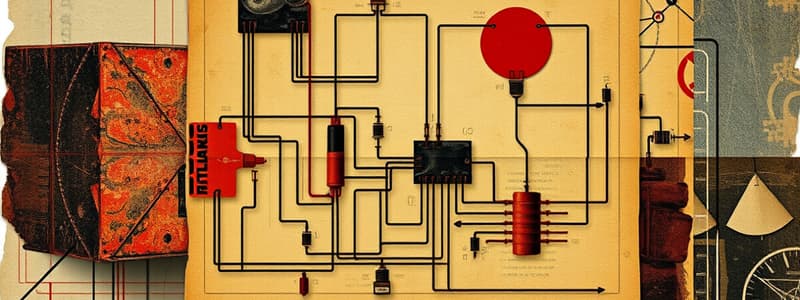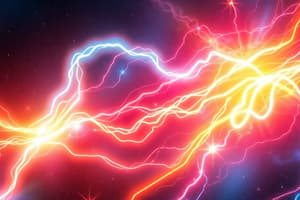Podcast
Questions and Answers
Which of the following heat transfer methods involves the movement of particles through a fluid?
Which of the following heat transfer methods involves the movement of particles through a fluid?
- Convection (correct)
- Conduction
- Radiation
- Insulation
Conduction only occurs in gases.
Conduction only occurs in gases.
False (B)
What is the unit of electrical resistance?
What is the unit of electrical resistance?
Ohms
Radiation involves the transfer of heat energy via __________.
Radiation involves the transfer of heat energy via __________.
Match the following terms with their definitions:
Match the following terms with their definitions:
What is the primary function of a fuse in a household circuit?
What is the primary function of a fuse in a household circuit?
All objects emit heat radiation above absolute zero.
All objects emit heat radiation above absolute zero.
What is the unit of voltage?
What is the unit of voltage?
Flashcards are hidden until you start studying
Study Notes
Heat and Temperature
- Heat is measured in Joules (J).
- Temperature is a scale used to determine the thermal state of a substance.
Heat Transfer Methods
- Conduction: Heat transfer through direct contact of particles. Heat is passed as particles gain energy and vibrate.
- Convection: Heat transfer in fluids (liquids and gases) where heated particles rise and cooler ones sink, creating a loop.
- Radiation: Transfer of heat energy through electromagnetic waves. All objects above absolute zero emit heat radiation.
Electrical Concepts
- Current: The flow of electric charge, measured in Amperes (A).
- Voltage: The potential difference between two points in a circuit, measured in Volts (V).
- Resistance: Opposition to current flow in a circuit, measured in Ohms (Ω).
Circuit Components
- Circuits include components like switches, resistors, and voltmeters.
- Series Circuit: Components connected in a single loop; current is the same through all components.
- Parallel Circuit: Components connected across common points; voltage is the same across each branch.
Circuit Safety Features
- Household circuits often feature safety elements such as fuses and circuit breakers to prevent overloads.
Heat Absorption and Emission
- Absorption: Process by which an object takes in heat energy.
- Emission: Process by which an object gives out heat energy in the form of radiation.
- Reflection: Heat radiation bouncing back from an object.
Examples of Heat Transfer
- A metal saucepan handle getting hot exemplifies conduction as heat transfers from the hot contents to the handle.
- Greenhouses utilize radiation as they trap heat from sunlight.
Summary of Concepts
- Conduction occurs in solids, convection occurs in fluids, and radiation occurs in all states of matter.
- Complex circuits can have multiple pathways and must ensure that all components operate effectively under the same voltage.
Studying That Suits You
Use AI to generate personalized quizzes and flashcards to suit your learning preferences.




